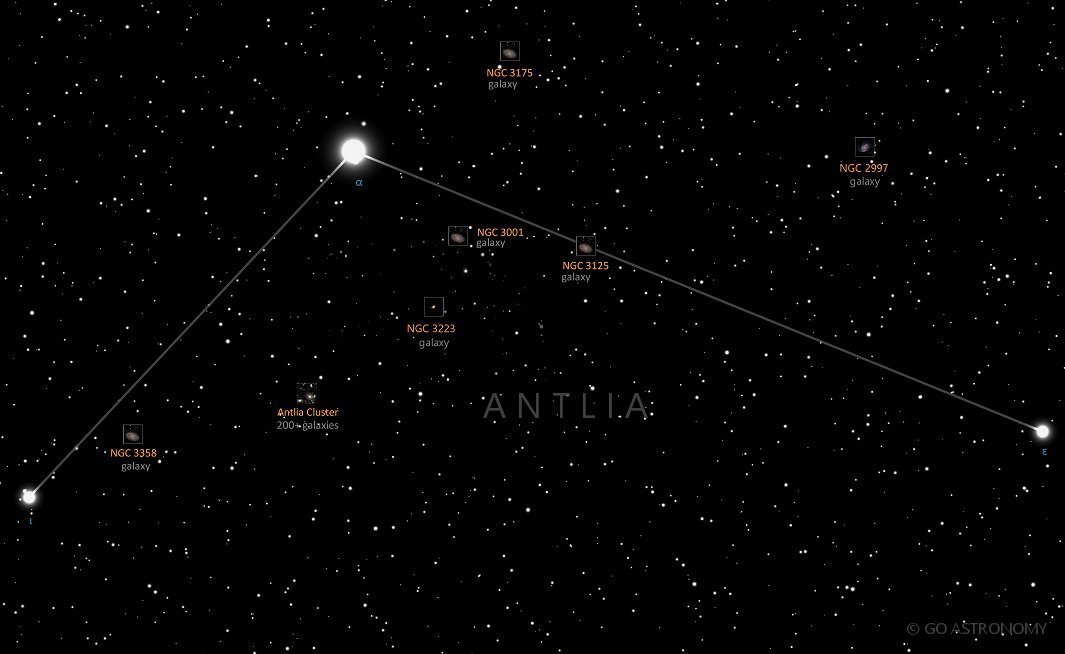Antlia, the Air Pump (Ant)
(ANT-lee-uh)
The Southern constellation of Antlia, the Air Pump, is best viewed in Spring during the month of April.
Antlia is the 62nd largest constellation. It's brightest star is Antliae at magnitude 4.20. The boundary of the Antlia constellation contains 2 stars that host known exoplanets.
- Pronunciation:
- ANT-lee-uh
- Meaning:
- Air Pump
- Genitive:
- Antilae
- Abbreviation:
- Ant
- Constellation Family:
- LaCaille
- Hemisphere:
- Southern
- Quadrant:
- SQ2
- Visibility:
- 45° N - 90° S
- Best viewing month*:
- April
- Area:
- 239 sq. degrees
- Size:
- 62nd largest
- Right Ascension (avg):
- 10h 7m
- Declination (avg):
- -34°
- Brightest star:
- Antliae (4.20)
- Stars with planets:
- 2
- X-ray stars:
- 1 stars
- Messier objects:
- |
- Caldwell objects:
- |
Brightest Stars in Antlia
The 10 brightest stars in the constellation Antlia by magnitude.
- Star
- Magnitude
- Spectral class
- Alpha Antliae (α Ant)
- 4.28
- K4III
- Epsilon Antliae (ε Ant)
- 4.51
- K3III
- Iota Antliae (ι Ant)
- 4.6
- K0III
- Theta Antliae (θ Ant)
- 4.78
- A7V+
- Eta Antliae (η Ant)
- 5.23
- A8IV
- HD 90132
- 5.34
- A8V
- HD 96146
- 5.43
- A0V
- HD 82205
- 5.49
- K2IIICNII
- U Antliae (U Ant)
- 5.5
- C6,3
- AG Antliae (AG Ant)
- 5.52
- B9.5Ib/II
Galaxies in Antlia
The most notable galaxies in the constellation Antlia. Also see all galaxies.
Milky Way Satellites in Antlia
Dwarf satellite galaxies that orbit the Milky Way Galaxy located in the constellation Antlia. Also see all Milky Way satellite galaxies.
- Galaxy name
- Alt name
- Magnitude
- Antlia 2
The Celestial Air Pump
Antlia is a small, faint constellation in the southern hemisphere, situated in a relatively unremarkable area of the sky. Named after the air pump, Antlia is often overlooked by both amateur and professional astronomers due to its lack of bright stars and prominent deep sky objects. However, this quiet and humble constellation holds a few hidden gems for those willing to explore it.
History and Mythology
Antlia is not associated with any myths and is a relatively modern constellation. It was originally charted by the French astronomer Nicolas Louis de Lacaille in the 18th century during his expedition to the Cape of Good Hope. Lacaille was known for naming constellations after scientific instruments and concepts, a trend that is clearly reflected in Antlia, which is Latin for "The Air Pump".
Location and Features
Located south of the celestial equator, Antlia is bordered by the constellations Hydra, Pyxis, Vela, and Centaurus. It is best viewed in the months of March and April. However, due to its southerly location, it is not visible from many northern latitudes.
Antlia lacks stars brighter than fourth magnitude, making it challenging to find in the night sky. The brightest star in the constellation, Alpha Antliae, is a cool red giant that has a visual magnitude of 4.25. Beta Antliae, the second brightest star, is a yellow giant and is somewhat fainter.
Deep Sky Objects
Despite its relative obscurity, Antlia contains a few notable deep sky objects for the dedicated observer. The Antlia Dwarf, a dwarf spheroidal galaxy that is part of the Local Group of galaxies, is located in this constellation. However, with an apparent magnitude of 16, it is a challenging object to observe.
The Antlia Cluster, a cluster of galaxies that is one of the farthest clusters observable by amateur astronomers, is also found within the boundaries of Antlia. This cluster contains nearly 234 galaxies and lies about 133 million light years away from Earth. Within this cluster, the galaxies NGC 3258 and NGC 3268 are the brightest and most dominant.
Observing Antlia
Observing Antlia can be a challenge due to its faint stars and southern location. The constellation is best seen from the southern hemisphere during the fall and early winter months. Despite these challenges, the Antlia Cluster of galaxies provides an exciting target for those with larger telescopes and darker skies.
* Constellation shown for northen hemisphere skies. For the southern hemisphere, constellations appear rotated 180 degrees (upside-down and left-right reversed) from what is shown. Remember that seasons are reversed too - summer in northern latitudes is winter in southern latitudes.
** Circumpolar constellations are visible year-round in the hemisphere listed (and not at all in the opposite hemisphere).





